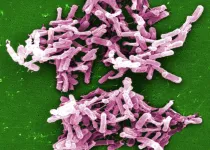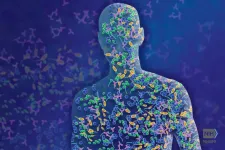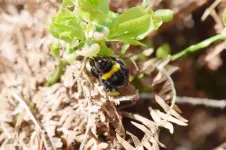(Press-News.org) Most survivors of squamous cell head and neck cancers report that their sense of taste is dulled, changed or lost during radiation treatment, causing them to lose interest in eating and diminishing their quality of life.
In a study of taste and smell dysfunction with 40 cancer survivors, scientists at the University of Illinois Urbana-Champaign found that the tips of these individuals' tongues were significantly less sensitive to bitter, salty or sweet tastes than peers in the control group who had never been diagnosed with cancer.
In a paper published in the journal Chemical Senses, the U. of I. team said this diminished taste sensitivity suggested that the taste buds on the front two-thirds of the cancer survivors' tongues or a branch of the chorda tympani facial nerve, which carries signals from the tip of the tongue to the brain, may have been damaged during radiation therapy.
"While most studies suggest that patients' ability to taste recovers within a few months of treatment, patients report that they continue to experience taste dysfunction for years after treatment ends," said M. Yanina Pepino, a professor of food science and human nutrition at the U. of I. "Our primary goal in this study was to test the hypothesis that radiation therapy is associated with long-term alterations in patients' senses of smell and taste."
While undergoing radiation and/or chemotherapy, head and neck cancer patients may lose taste buds, triggering a transient reduction in their ability to taste - a condition called hypogeusia - or their perception of tastes may be altered, a condition called dysgeusia that can also occur when nerves are damaged during cancer surgery, she said.
"Taste buds' average lifespan of about 10 days enables rapid recovery from injury if the stem cells are preserved, yet it also makes the short-lived and long-lived cells within taste buds particularly vulnerable to the direct cytotoxic and anti-proliferative effects of chemotherapy and radiotherapy," Pepino said.
Prior studies that explored taste loss and perception in these patients showed mixed results. Many of these studies involved "whole mouth" experiments that may not have detected regional damage to the taste buds at the front of the tongue or to the chorda tympani section of the facial nerve, said graduate student Raul Alfaro, the lead author of the study.
The U. of I. team assessed participants' smell and taste functions separately and explored whether sensory interactions between taste and retronasal odors - aromas from food and beverages that are perceived in the oral cavity while eating or drinking - differed for the cancer survivors and the people in the control group.
The team assessed participants' ability to taste regionally by applying cotton swabs soaked in flavored solutions to the tips of their tongues.
They also evaluated participants' whole-mouth taste function by having them swish solutions around in their mouths for five seconds and spit them out. For this test, the participants were presented with nine cups of liquids that contained both taste and smell sensory components. The cups contained two concentrations of strawberry extract in a sucrose solution, lemon extract in citric acid, salt in a vegetable broth and caffeinated instant coffee. They also received one cup of deionized water.
After sipping each sample, participants were asked to identify its taste quality - sweet, salty, bitter, umami (savory) or no sensation - and to rate the smell and taste intensity of the sample on a scale that ranged from "no sensation" to "strongest of any kind."
Participants tasted the samples twice - once wearing a nose clip and once without - to determine whether their taste perception differed when the nose clip blocked their retronasal olfactory cues.
When participants' sense of taste was assessed using the whole-mouth test with or without the nose clip, they similarly rated the taste and smell of nearly all of the samples.
However, when participants' sense of taste was assessed regionally at the tip of the tongue, the cancer survivors were more likely to respond they did not perceive a taste or to misidentify the taste quality - such as bitter, salty or sweet - of multiple samples.
"Although the results from the whole-mouth taste test suggested that head and neck cancer survivors' taste function was normal and well preserved, results from the regional tests indicated that they had some deficits," Pepino said. "Subtle taste dysfunction in the tip of the tongue persisted for several months after they completed their oncology treatments.
"Taste dysfunction at the tip of the tongue might sound unimportant; however, there is an elegant cross-talk between the nerves that conveys signals from the tip and the back of the tongue, such that taste signals in the tip of the tongue inhibit signaling from the back. This system allows taste intensity to remain constant in the whole mouth, even when taste signaling coming from the tip of the tongue is reduced. However, reduced signal input can also lead to phantom tastes, metallic taste and other oral symptoms."
INFORMATION:
Additional co-authors of the study were food science and human nutrition professor Anna E. Arthur, who is also the Sylvia D. Stroup Scholar in Nutrition and Cancer, and an oncology dietitian with the Carle Cancer Center; Dr. Kalika P. Sarma, a radiation oncologist at Carle Foundation Hospital and a clinical assistant professor in the Carle Illinois College of Medicine; and then-research fellow Sylvia L. Crowder.
The work was supported by grants from the U.S. Department of Agriculture National Institute of Food and Agriculture, the Academy of Nutrition and Dietetics, and the Division of Nutritional Sciences at the U. of I.
Crowder's work on the project was supported by a Carle Illinois Cancer Scholars for Translational and Applied Research Fellowship, as well as a grant from the National Cancer Institute.
In New England, constraints in the supply of natural gas have led to nearly a quarter of all unscheduled power plant outages. In a new study, researchers used data from power plant failures in the 2010s to develop a supply curve of the costs required for generators to mitigate fuel shortages in the region. The study found that storing both oil and gas on-site could reduce dependence by power plants on gas grids in geographic areas with few pipelines.
The study was conducted by researchers at Carnegie Mellon University (CMU), The Pennsylvania State University, and the North American Electric Reliability Corporation. It is published in The Electricity Journal.
"Gas ...
Toronto - Last winter, Goldman Sachs reported it was working to make things better after a group of junior analysts revolted against 100-hour work weeks.
That's a smart thing to do, suggests a new study from the University of Toronto's Rotman School of Management. Drawing from more than 6,000 employee reviews of their workplaces and data on their firms' forecasting accuracy, the research shows that making improvements to hardworking analysts' work-life balance produces dividends for the company and for the analysts' careers.
"There is a lot of anecdotal evidence, but here we provide large-scale evidence that supports the recent push to grant these employees at least some reprieve from the extremes of their jobs," said Ole-Kristian Hope, who is the Deloitte Professor of Accounting ...
The Gerontological Society of America's highly cited, peer-reviewed journals are continuing to publish scientific articles on COVID-19. The following were published between May 4 and June 14; all are free to access: Cardiometabolic therapy and mortality in very old patients with diabetes hospitalized due to COVID-19: Research article in The Journals of Gerontology, Series A: Biological Sciences and Medical Sciences by Jose Manuel Ramos-Rincón, MD, PhD, Luis M. Pérez-Belmonte, MD, PhD, Francisco Javier Carrasco-Sánchez, MD, PhD, Sergio Jansen-Chaparro, MD, PhD, Mercedes De-Sousa-Baena, MD, José Bueno-Fonseca, MD, ...
Best known for its presence in house cats and a tendency to infect and alter the behaviors of rodents and humans, the parasite Toxoplasma gondii (T. gondii) is also associated with bold behavior among wild hyena cubs and risk of death during interactions with lions, finds new research from the University of Colorado Boulder.
The findings, published this week in Nature Communications, reinforce previous research which has found the parasite can prompt profound behavioral changes in its hosts, and potentially in the 2 billion people worldwide estimated to be infected by it. While T. gondii has been well studied in laboratory settings with humans and wild-caught ...
Researchers from Charité - Universitätsmedizin Berlin and the University of California in San Francisco were able to show for the first time that a very low calorie diet significantly alters the composition of the microbiota present in the human gut. In a current Nature* publication, the researchers report that dieting results in an increase of specific bacteria - notably Clostridioides difficile, which is associated with antibiotic-induced diarrhea and colitis. These bacteria apparently affect the body's energy balance by exerting an influence on the absorption of nutrients ...
WHAT:
National Institutes of Health scientists and their collaborators have identified an internal communication network in mammals that may regulate tissue repair and inflammation, providing new insights on how diseases such as obesity and inflammatory skin disorders develop. The new research is published in Cell.
The billions of organisms living on body surfaces such as the skin of mammals--collectively called microbiota--communicate with each other and the host immune system in a sophisticated network. According to the study, viruses integrated in the host genome, remnants of previous infections called endogenous retroviruses, can ...
Researchers at the RIKEN Center for Brain Science and the RIKEN BioResource Research Center in Japan, along with collaborators at the State University of New York at Buffalo, have created a mouse model that allows the study of naturally occurring melatonin. Published in the Journal of Pineal Research, these first experiments using the new mice showed that natural melatonin was linked to a pre-hibernation state that allows mice to slow down their metabolism and survive when food is scarce, or temperatures are cold.
Melatonin is called "the hormone of darkness" because it's released by the brain in the dark, which usually means at night. It tells the body when it's dark outside so that the body can switch to 'night mode'. Although other hormones are easily studied in the laboratory, ...
How many tree species are there in the forest? How are the trees scattered throughout? How high are the individual tree crowns? Are there fallen trees or hollowed-out tree trunks? Forest scientists characterize forests according to structural factors. "Structural richness is very important for biodiversity in forests. But forests used for forestry are generally poor in terms of structure," says Tristan Eckerter from the Chair of Nature Conservation and Landscape Ecology at the University of Freiburg. Therefore, together with research teams from the Chair of Silviculture and the Black Forest National Park, he investigated ...
A new article published in the Journal of the Association for Consumer Research presents a neural model of maladaptive consumption.
Consumption (of, for instance, substances, food, and online media) is driven mainly by expected rewards that stem from the ability of the consumption act to satisfy intrinsic (e.g., curiosity) and extrinsic (e.g., job performance) needs. In the article, "A Triple-System Neural Model of Maladaptive Consumption," the authors define maladaptive consumption as a state of compulsive seeking and consumption of rewarding products or experiences, which are sustained despite the negative consequences of such behaviors.
"Understanding the neural basis of maladaptive ...
Pairing blueberry pie with a scoop of ice cream is a nice summer treat. Aside from being tasty, this combination might also help people take up more of the "superfruit's" nutrients, such as anthocyanins. Researchers reporting in ACS' Journal of Agricultural and Food Chemistry show that α-casein, a protein found in cow's milk, helped rats absorb more blueberry anthocyanins and their byproducts, boosting accessibility to these good-for-you nutrients.
In studies, anthocyanins have been shown to have antioxidant properties, lower blood pressure and reduce the risk of developing some cancers. However, only small amounts of these nutrients are absorbed ...






